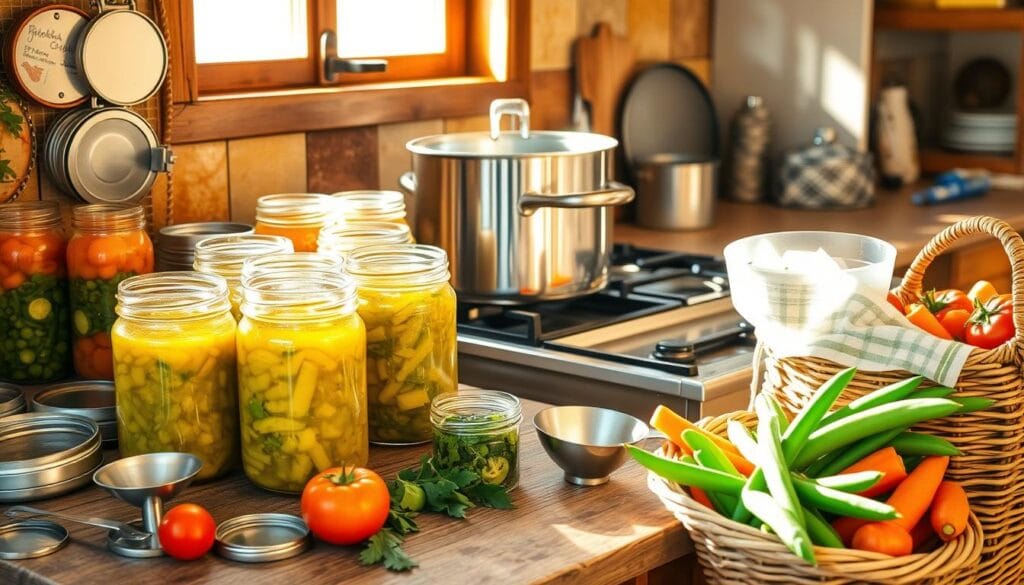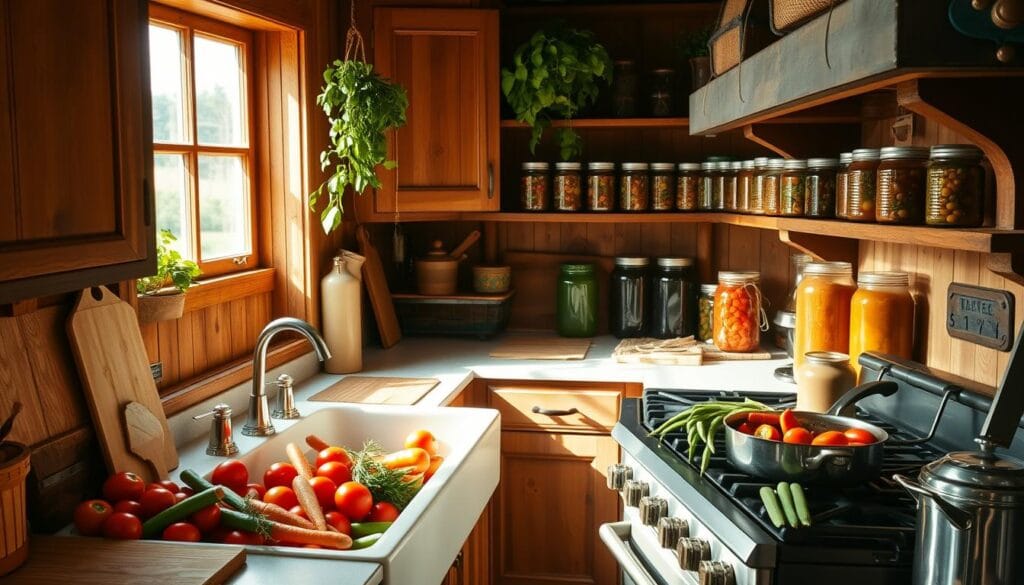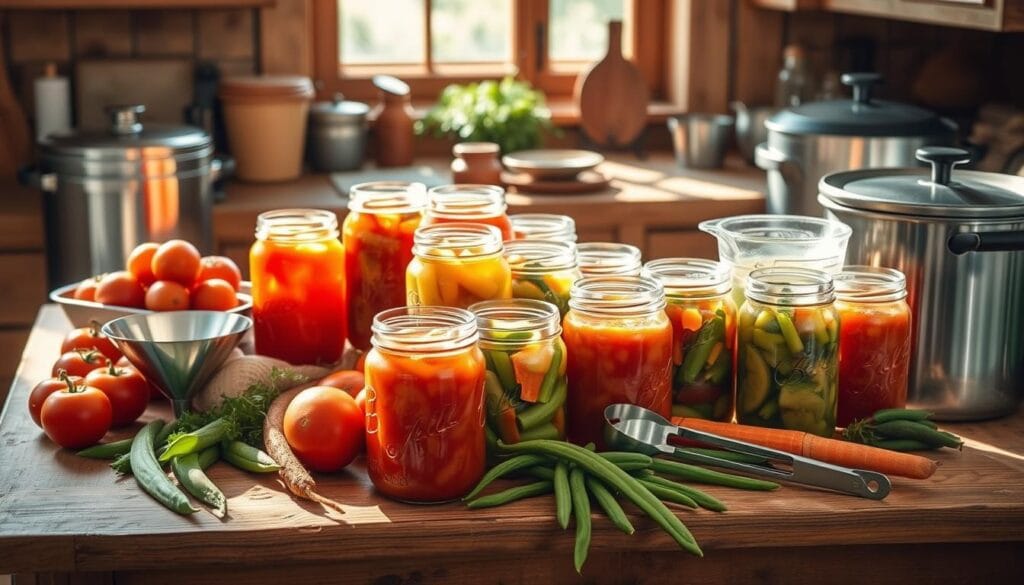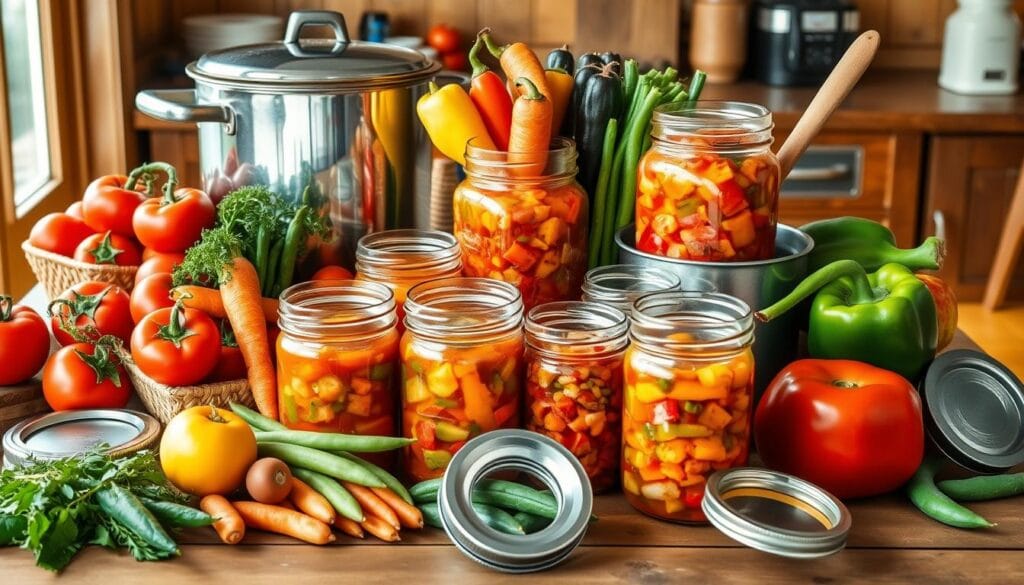As a homesteader, I love preserving my garden’s bounty. Homesteader canning vegetable soup recipe is a great way to do this. It lets me enjoy fresh flavors all year, which is very rewarding. Preserving food is key for homesteaders, and using a homesteader canning vegetable soup recipe is both practical and tasty. By following a simple recipe, you can enjoy your favorite soups anytime. I’ll share my experience and guide you through canning delicious vegetable soup. We’ll cover homesteading, preserving food, and tips for a successful canning experience.
Understanding the Basics of Canning Vegetable Soup
Canning vegetable soup helps you be self-sufficient and live sustainably. By using home canning tips, you can save your favorite soup for later. Canning seals food in airtight containers and heats it to reduce bacteria. If you’re looking for another healthy homemade option, check out our healthy gluten-free banana bread with chocolate – no sugar! for a sweet and nutritious treat.
There are two main canning methods: water-bath and pressure canning. Water-bath canning is simpler and cheaper. But, pressure canning is needed for foods like meats and soups. You’ll need a big pot, jars, lids, and a canner to start.

When canning, remember to use the right tools and follow tested recipes. Also, know the food’s acidity level. By doing this, you can make tasty, healthy canned soup. This supports sustainable living and self-sufficiency.
Homesteader Canning Vegetable Soup Recipe Ingredients
As a homesteader, I choose the freshest, best-quality vegetables for canning. This makes my soup taste great and have the right texture. The key to a delicious vegetable soup is using a variety of ingredients. These should add flavor and nutrition.
For a preserving harvest, pick ingredients that are plentiful during a good growing season. My recipe includes tomato juice, potatoes, carrots, green beans, corn, cabbage, and seasonings. I also add beans, lentils, or chicken for extra flavor and nutrition.
Fresh Vegetables for Flavor
The freshness of the vegetables is key in this recipe. I mix homegrown and store-bought produce. This includes 3 pounds of fresh diced potatoes, 1 quart of canned carrots, and 2 pounds of fresh carrots.
Alternative Proteins to Use
I also add alternative proteins to my soup. Options like beans, lentils, or chicken add flavor and protein. These are great for a vegetable soup canning guide because they make the soup nutritious and filling.
Herbs and Spices to Enhance Taste
To make my soup taste better, I use herbs and spices like salt, pepper, and other seasonings. These ingredients enhance the natural flavors of the vegetables. By following this vegetable soup canning guide, you can make a delicious, healthy meal. It’s perfect for preserving harvest and enjoying all year.
Preparing Your Vegetables for Canning
To can food at home, you must prepare your veggies right. This is key in a homestead kitchen. It keeps your canned food safe and tasty.
Begin by washing, peeling, and chopping fresh veggies as your recipe says. For instance, if you’re making vegetable soup, wash and chop carrots, onions, and celery.
Washing and Cutting Techniques
Wash and cut your veggies in a clean, sanitized area. This stops contamination. It makes sure your veggies are clean for canning.
Pre-cooking Vegetables: When and Why
Some veggies, like green beans and broccoli, need pre-cooking. This makes them tender and removes extra moisture. It helps them can and store better. For more meal ideas, try our easy recipes with gluten-free cream of chicken soup for quick and hearty options.

The Importance of Uniform Sizing
Uniform sizing is key for even cooking and keeping. Use a mandoline or sharp knife to slice veggies the same size. This ensures they cook well and are preserved right.
By following these steps and using the right techniques, you can get your veggies ready for canning. This makes your home food preservation strategy a success in your homestead kitchen.
Canning Equipment Essentials for Homesteaders
As a homesteader, having the right equipment is key for home canning. For canning vegetable soup, you need some must-have tools. These tools make the process easier and safer. Here, I’ll list the essential equipment for canning, including homesteading favorites.
You’ll start with basic items like a pressure canner, canning jars, and lids. Also, a jar lifter, canning funnel, ladle, and bubble remover are useful. And don’t forget basic kitchen items like a cutting board, knives, and a large pot for cooking.

- Pressure canner: This is a critical piece of equipment for canning low-acid foods like vegetable soup.
- Canning jars and lids: Choose jars and lids made for canning and fit your pressure canner.
- Jar lifter: This tool helps lift hot jars from the pressure canner to a cooling rack.
By getting these essential items, you’re ready for successful home canning. You’ll enjoy homemade vegetable soup all year. Always follow safe canning practices and guidelines. This ensures your canned goods are safe and last long, which is important for homesteading.
Step-by-Step Guide to the Homesteader Canning Vegetable Soup Recipe
As a homesteader, preserving food is key. Canning vegetable soup is a smart way to do this. Start by making a tasty soup base with ground beef, onions, garlic, and veggies.
When canning, it’s important to leave the right amount of space in jars. This helps create a vacuum seal and keeps food fresh. For soups, leave about 1 inch of space.
Creating the Soup Base
Begin by mixing your ingredients in a big pot. Simmer them for 20-30 minutes. This step is important for getting the flavors right in your homesteader canning vegetable soup recipe.
Filling the Jars with Soup
After your soup base is ready, fill the jars. Make sure to leave the right amount of space. Remove air bubbles and clean the jar rims.
Sealing and Processing Your Jars
Seal the jars and then process them in a pressure canner. Follow the right pressure and time for your area. This is key for preserving food safely.
By following these steps and using the homesteader canning vegetable soup recipe, you can enjoy your soup all year. You’ll know you’ve preserved it safely.
Tips for Storing Canned Vegetable Soup
As a homesteader, I’ve learned the importance of a good home food preservation strategy. This is key for enjoying my canned vegetable soup all year. I cool the canner down after canning, then remove the jars to cool fully. This prevents damage to jars or their seals.
After the jars cool, I check the seals and store them in a cool, dark place. This is part of my sustainable living approach. It keeps food quality high and reduces waste. Storing in a cool, dry area preserves flavor and texture, and helps me track my inventory.
Some other tips for storing canned vegetable soup include:
- Keeping the jars away from direct sunlight and heat sources
- Using airtight containers to store the jars and prevent moisture from entering
- Labeling the jars with the date and contents, so I can easily keep track of what I have and how long it’s been stored
By following these simple tips, I can enjoy my canned vegetable soup for up to 12 months. I’m confident that my home food preservation strategy supports a more sustainable living lifestyle.
Troubleshooting Common Canning Issues
As a homesteader, I’ve faced many canning problems. These include jars that don’t seal and signs of spoilage. It’s key to follow food preservation steps and know common mistakes. Here, I’ll share home canning tips to help you fix these issues.
Sealing jars is a big deal in canning. If a jar doesn’t seal, it can spoil and grow harmful bacteria. Always check jars for damage and make sure lids seal tight after processing.
Identifying Spoilage Signs
Knowing spoilage signs is vital. Look for swelling, leakage, or bad smells. If you see these, throw out the jar. By following home canning tips and food preservation methods, you can avoid spoilage and enjoy your food safely.
Adjusting Recipes for Altitude
Altitude is another thing to think about when canning. At high elevations, you need to change recipes and processing times. This ensures jars are sterilized and sealed right. By understanding altitude’s impact and using the right home canning tips, you can get great results and enjoy your food all year.
Creative Ways to Use Canned Vegetable Soup
In my homestead kitchen, I’ve found canned vegetable soup very useful. It’s great for making different dishes and helps us be more self-sufficient. I’ve tried many vegetables to make different flavors, like minestrone and beef and vegetable soup. It’s fun to try new recipes and find my favorite flavors. For more hearty meal inspirations, explore our beef quesadilla recipe that pairs perfectly with canned soup as a side.
Canned vegetable soup is also very convenient. It’s perfect for quick meals when we’re busy. For example, I mix it with rice and vegetables for a tasty meal. I also use it in soups, stews, and casseroles.
Quick Meal Ideas with Canned Soup
- Add canned soup to a pot of rice and vegetables for a quick and easy meal
- Use canned soup as a base for a hearty stew or casserole
- Mix canned soup with some cream and herbs for a delicious and creamy sauce
Using canned vegetable soup in my recipes has changed my kitchen. It helps me make many dishes and be more self-sufficient. Whether it’s a simple meal or a complex dish, canned vegetable soup is always handy.

My Final Thoughts on Canning Vegetable Soup
As a dedicated homesteader, canning vegetable soup is key for me. It helps me use up my garden’s harvest. This way, my family gets tasty soups all year.
For new homesteaders, I say give canning a try. It might seem hard at first, but it’s worth it. Making your own canned goods is very rewarding.
I want to hear about your canning adventures. What worked well for you? What challenges did you face? Together, we can all get better at making delicious soups.

